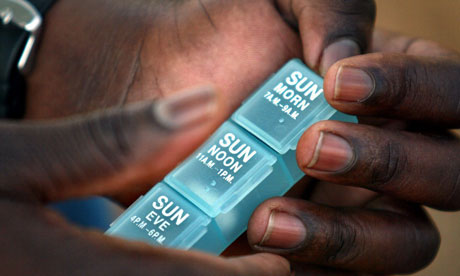
The global Aids epidemic is steadily being turned around, with the number of deaths and new infections coming down, but progress is worryingly slow, according to a major report from the UN.
Deaths dropped from 1.8 million in 2010 to 1.7 million last year, while new infections came down from 2.6 million to 2.5 million, according to the 140-page report from UNAids published before the international Aids conference, which begins this weekend in Washington. It is progress, but slower than experts would like, especially at a time when funding is under pressure because of the global economic downturn.
"These are positive numbers but the trend needs to be accelerated," said Paul De Lay, the deputy executive director of UNAids. "It is moving in the right direction, but just not fast enough. If we map it out on a graph, we are still looking at a significant epidemic for the next 40 to 50 years.
"It is something of a depressing message, but it could be worse. It could be that the numbers are going up."
Aids has become a regionalised epidemic and in some countries, deaths and infections are still rising, with both new infections and deaths going up in eastern Europe and central Asia. "These two epidemics are counter to the rest of the world," said De Lay. Those most affected are drug users and sex workers and their clients – groups that are still stigmatised and do not get the treatment and help they need.
The best news is a sharp rise in the numbers of people with HIV who are getting treatment in low- and middle-income countries. Some 8 million people are on drugs that suppress the virus, keeping them not only healthy but less likely to infect anyone else. That is a rise from 6.6 million last year. De Lay called it "a really exciting number – the largest single year increase we have ever had".
The report says we are on target to get 15 million people on treatment by 2015, although that will require an ambitious yearly increase of 1.7 million people – and last year's record increase was 1.4 million people.
At the conference beginning this weekend, held in the US for the first time since 1990 after Barack Obama lifted a ban on people with HIV entering the country, there will be calls for far more of the 34 million people living with HIV to get drug treatment. Studies have shown that people put on antiretroviral drugs early are barely infectious – and that drugs given to healthy people whose partners have HIV protect them from infection.
But there are also concerns over drug resistance, which are flagged up by a separate World Health Organisation report published on Wednesday. In affluent countries, many people with HIV have had to move from one drug combination to another as the virus has evolved. HIV easily mutates into a drug-resistant form if the levels of drug in the body drop.
Resistance is building in the developing world, as it did in rich countries, but more slowly. By 2010, 6.8% of HIV cases in low and middle-income countries had been found to be drug-resistant, compared with 8% to 14% over a similar period of time in the affluent countries.
"Simpler regimens using fixed-dose combinations have made it much easier for people to adhere to antiretroviral treatment, limiting the spread of drug resistance in recent years. This is good news for public health," says Dr Gottfried Hirnschall, the director of WHO's HIV department. "Our task now is to ensure that drug resistance remains limited and manageable."
But worryingly, studies in 12 developing countries have shown that clinics lose contact with more than a third (38%) of the HIV patients they treat with drugs. That is not only serious for them – they are likely to get ill and die without treatment – but it could potentially increase the spread of drug-resistant strains of HIV.
"That is indeed very worrying," said Hirnschall. "That figure includes people who die and people who move – in many settings there is a highly mobile population. But it is what we call an early warning signal. Something is not right." It underlined the importance for clinics of keeping track of those they treat, he said.
In spite of the financial climate, which has resulted in declining funding for Aids from Europe, total spending on fighting the epidemic has flatlined and not dropped. Affected developing countries have increased their contribution and now put in more than half of all the money for Aids programmes – $8.6bn (£5.5bn) of the $16.8bn spent last year.
But there is still a shortfall of $7bn in the amount experts calculate is needed to fight back against the epidemic. It is estimated that $22bn to $24bn is needed by 2015. The US already puts in 48% of all international assistance, but it will come under pressure at next week's conference on its home turf to do still more.

